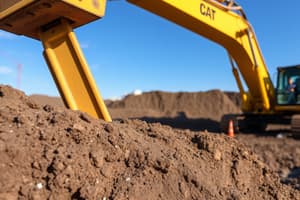Podcast
Questions and Answers
What does OSHA define a trench as?
What does OSHA define a trench as?
A narrow excavation made below the surface of the ground in which the depth is greater than the width - with the width not to exceed 15 feet.
How does OSHA define an excavation?
How does OSHA define an excavation?
Any man-made cavity, depression, trench, or cut in the earth's surface formed by earth removal.
There is usually some form of warning before a cave-in.
There is usually some form of warning before a cave-in.
False (B)
What methods does OSHA require for protecting employees from cave-ins?
What methods does OSHA require for protecting employees from cave-ins?
According to OSHA, for every foot of depth in a simple slope excavation of 20 feet or less, how far must the trench be excavated back?
According to OSHA, for every foot of depth in a simple slope excavation of 20 feet or less, how far must the trench be excavated back?
Who must design or approve trench boxes or shields?
Who must design or approve trench boxes or shields?
When is shoring or shielding most often used in excavations?
When is shoring or shielding most often used in excavations?
In addition to cave-ins, what other hazards are excavation workers exposed to?
In addition to cave-ins, what other hazards are excavation workers exposed to?
Under what condition are employees allowed to work above others on the face of a sloped or benched excavation?
Under what condition are employees allowed to work above others on the face of a sloped or benched excavation?
What does OSHA require to prevent surface water from entering an excavation?
What does OSHA require to prevent surface water from entering an excavation?
Flashcards are hidden until you start studying
Study Notes
Trench and Excavation Definitions
- A trench is defined as a narrow excavation below ground with a depth greater than width, not exceeding 15 feet in width.
- An excavation is any man-made cavity or depression in the earth formed by removing earth.
Cave-in Warnings
- There is typically no warning before a cave-in occurs, indicating that workers must always be vigilant.
Protective Measures for Excavations
- OSHA mandates protection against cave-ins through methods such as sloping, benching, shoring, and shielding.
Slope Excavation Guidelines
- For simple slope excavations 20 feet or less deep, a back excavation of 1.5 feet is required for every foot of depth.
Design Approval for Trench Boxes
- Trench boxes or shields must be designed or approved by a registered professional engineer to ensure safety.
Conditions for Shoring and Shielding
- Shoring or shielding is frequently required when the excavation's location or depth makes sloping impractical.
Additional Hazards in Excavation Work
- Workers in excavation are at risk not only from cave-ins but also from falls, falling loads, and moving equipment.
Safety Regulations for Worker Positioning
- Employees are not allowed to work above others on sloped or benched excavations unless those below have overhead protection from falling objects.
Water Management Requirements
- To prevent water from entering excavations and ensure adequate drainage, OSHA standards require the implementation of water removal equipment, diversion ditches, dikes, or other appropriate methods.
Studying That Suits You
Use AI to generate personalized quizzes and flashcards to suit your learning preferences.




